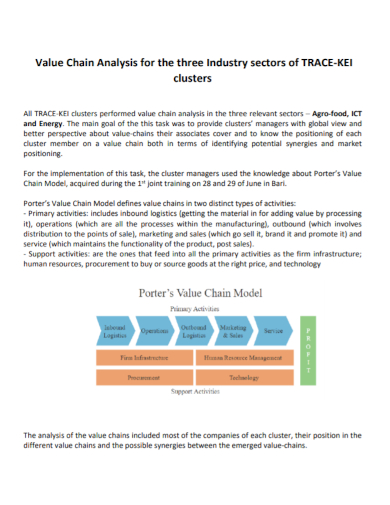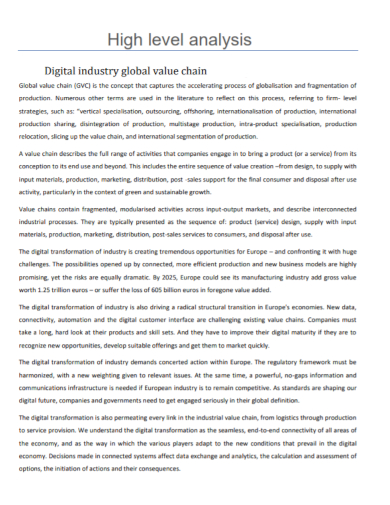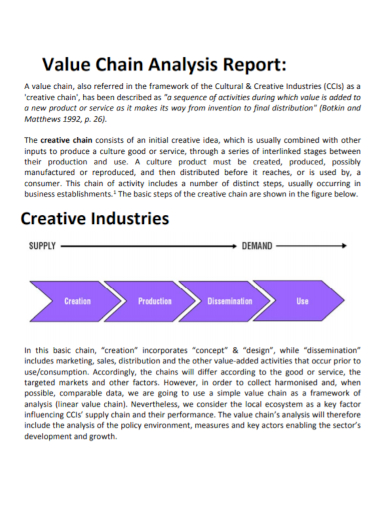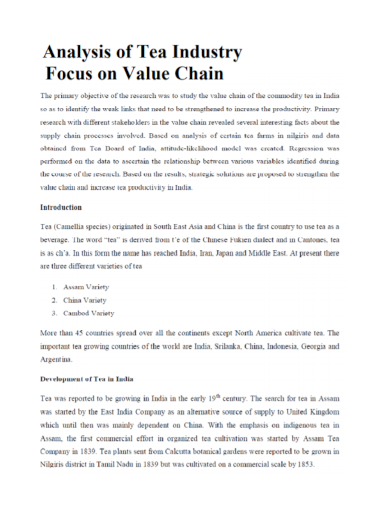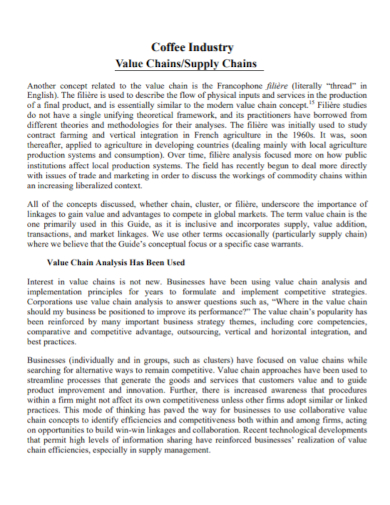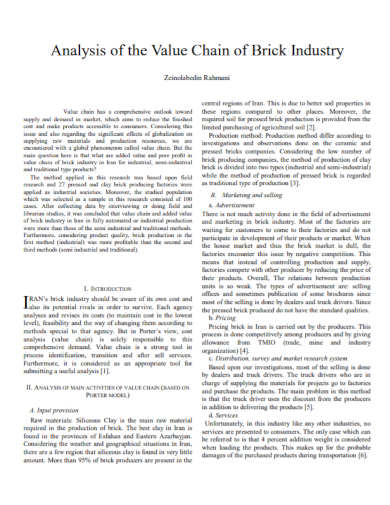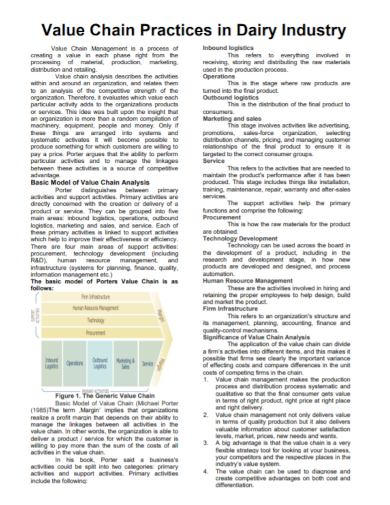The operations that go into producing a good product or service that customers value highly are identified through value chain analysis, a useful management technique. Customers’ willingness to pay a premium for this highly valued product results in increased profit because their purchases surpass the product’s costs. Michael Porter’s model is useful because it may divide work output into different activity categories, which helps management strategically concentrate on tasks that are profitable and add value. Additionally, it focuses a business on developing a vision for its future products and services using a competitive advantage strategy.
7+ Industry Value Chain Analysis Samples
Value chain analysis is a tool used in business planning to examine internal operations. Its objective is to identify the operations that are most important to the company and might be improved to give it a competitive advantage (i.e., those that are the source of cost or unique selling proposition). In other words, by looking at internal processes, the study exposes where a company’s competitive benefits or weaknesses are. The company with a differentiating advantage will outperform its rivals in all of its operations. It will attempt to carry out internal tasks at a cheaper cost than competitors would if it competes on price. A business makes money when it can produce things for less than the going rate or when it can offer better products.
1. Industry Value Chain Analysis
2. Digital Industry Value Chain Analysis
3. Industry Value Chain Analysis Report
4. Tea Industry Value Chain Analysis
5. Coffee Industry Value Chain Analysis
6. Brick Industry Value Chain Analysis
7. Diary Industry Value Chain Analysis
8. Industry Value Chain Situation Analysis
Conducting a Value Chain Analysis
Identify value chain analysis
Understanding all of the primary and secondary processes that go into the production of your commodity is the first step in carrying out a value chain analysis. It’s crucial to carry out this approach for each of your company and its products if you market a variety of them.
Determine the cost and value of activities
Finding the value that each operation brings to the process and its associated expenses comes next once the primary and secondary actions have already been established. Consider how each activity improves the end user’s happiness or delight when considering the value it creates. How does it create value for my firm? For instance, does using a particular material make a product more luxury or durable for the user? Does including one with a definite attribute likewise imply your company will stand to gain from network externalities and increased sales?
Similarly, it’s critical to know the costs involved with each part of the process. Depending on the circumstances, you may discover that cutting expenses is a straightforward method to raise the value each operation delivers.
Identify opportunities for competitive advantage
You can assess your value chain using the perspective of whatever competitive advantage you’re attempting to acquire once you’ve assembled it and comprehend the cost and value involved with each step. For instance, if cutting costs is your main priority, you should assess every link in your value chain from that perspective. Which procedures might be more effective? Exist any that could be deleted or outsourced in order to drastically cut expenses but still produce little value? Likewise, if your main objective is to reach market segmentation, which portions of your value chain give the best possibility to reach that goal? Would the value generated warrant the commitment of more resources?
FAQs
How to improve the value chain?
When a corporation considers its value chain, it needs to analyze its perceived value, or what sets it distinct from its competitors. Value chain analysis is aimed to boost profits by providing products or services that is so outstanding that customers are prepared to spend more than the expense to generate it. However, the ultimate objective shouldn’t be to just increase a value chain for its own sake. Instead, a business should consider its competitive edge and why it help to develop its value chain in order to stand out from its competitors.
How is VCA done if a firm competes on differentiation?
VCA is done differently when a corporation competes on difference rather than costs. This is because the source of differentiating advantage comes from making superior products, adding more features and satisfying varying client wants, which results in greater cost structure.
If you want to see more samples and formats, check out some industry value chain analysis samples and templates provided in the article for your reference.
Related Posts
FREE 10+ Make or Buy Analysis Samples in PDF
FREE 10+ Fishbone Root Cause Analysis Samples in PDF
FREE 11+ Cost Volume Profit Analysis Samples & Templates in PDF | MS Word
FREE 6+ Corporate Portfolio Analysis Samples in PDF
FREE 10+ Fault Tree Analysis Samples in PDF
FREE 10+ Comp Analysis Samples in PDF
FREE 10+ Fishbone Analysis Samples in PDF
FREE 10+ Individual Swot Analysis Samples in PDF
FREE 10+ 5 Year Analysis Samples in PDF
FREE 10+ Benefit Costs Analysis Samples in PDF
FREE 10+ Job Hazard Analysis Samples in PDF
FREE 10+ Primary Source Analysis Samples in PDF
FREE 10+ Critical Path Analysis Samples in PDF
FREE 10+ Competition Analysis Samples in PDF
FREE 10+ Activity Hazard Analysis Samples in PDF

